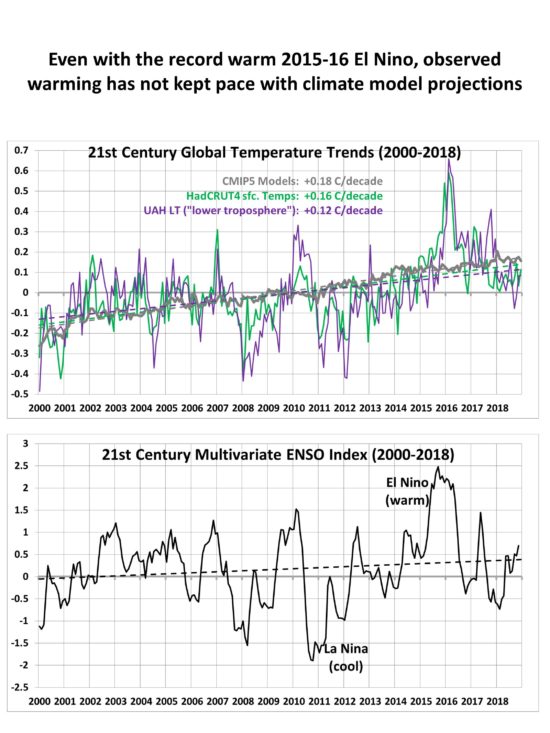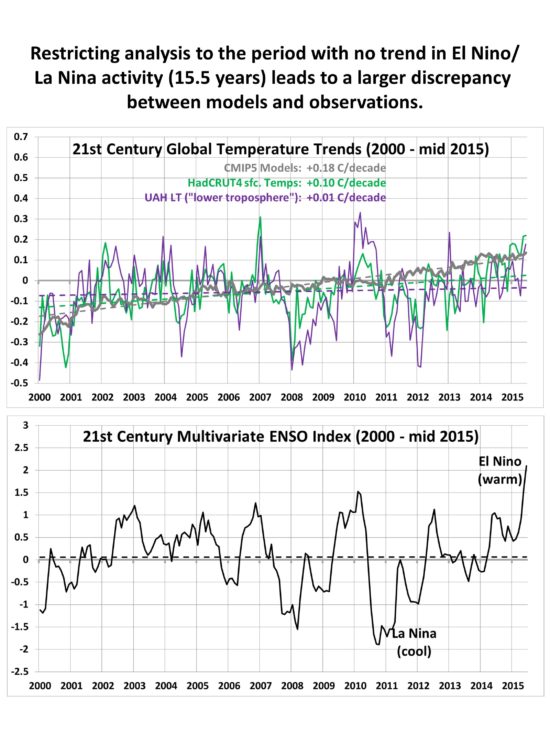A major uncertainty in figuring out how much of recent warming has been human-caused is knowing how much nature has caused. The IPCC is quite sure that nature is responsible for less than half of the warming since the mid-1900s, but politicians, activists, and various green energy pundits go even further, behaving as if warming is 100% human-caused.
The fact is we really don’t understand the causes of natural climate change on the time scale of an individual lifetime, although theories abound. For example, there is plenty of evidence that the Little Ice Age was real, and so some of the warming over the last 150 years (especially prior to 1940) was natural — but how much?
The answer makes as huge difference to energy policy. If global warming is only 50% as large as is predicted by the IPCC (which would make it only 20% of the problem portrayed by the media and politicians), then the immense cost of renewable energy can be avoided until we have new cost-competitive energy technologies.
The recently published paper Recent Global Warming as Confirmed by AIRS used 15 years of infrared satellite data to obtain a rather strong global surface warming trend of +0.24 C/decade. Objections have been made to that study by me (e.g. here) and others, not the least of which is the fact that the 2003-2017 period addressed had a record warm El Nino near the end (2015-16), which means the computed warming trend over that period is not entirely human-caused warming.
If we look at the warming over the 19-year period 2000-2018, we see the record El Nino event during 2015-16 (all monthly anomalies are relative to the 2001-2017 average seasonal cycle):

We also see that the average of all of the CMIP5 models’ surface temperature trend projections (in which natural variability in the many models is averaged out) has a warmer trend than the observations, despite the trend-enhancing effect of the 2015-16 El Nino event.
So, how much of an influence did that warm event have on the computed trends? The simplest way to address that is to use only the data before that event. To be somewhat objective about it, we can take the period over which there is no trend in El Nino (and La Nina) activity, which happens to be 2000 through June, 2015 (15.5 years):

Note that the observed trend in HadCRUT4 surface temperatures is nearly cut in half compared to the CMIP5 model average warming over the same period, and the UAH tropospheric temperature trend is almost zero.
One might wonder why the UAH LT trend is so low for this period, even though in Fig. 1 it is not that far below the surface temperature observations (+0.12 C/decade versus +0.16 C/decade for the full period through 2018). So, I examined the RSS version of LT for 2000 through June 2015, which had a +0.10 C/decade trend. For a more apples-to-apples comparison, the CMIP5 surface-to-500 hPa layer average temperature averaged across all models is +0.20 C/decade, so even RSS LT (which usually has a warmer trend than UAH LT) has only one-half the warming trend as the average CMIP5 model during this period.
So, once again, we see that the observed rate of warming — when we ignore the natural fluctuations in the climate system (which, along with severe weather events dominate “climate change” news) — is only about one-half of that projected by climate models at this point in the 21st Century. This fraction is consistent with the global energy budget study of Lewis & Curry (2018) which analyzed 100 years of global temperatures and ocean heat content changes, and also found that the climate system is only about 1/2 as sensitive to increasing CO2 as climate models assume.
It will be interesting to see if the new climate model assessment (CMIP6) produces warming more in line with the observations. From what I have heard so far, this appears unlikely. If history is any guide, this means the observations will continue to need adjustments to fit the models, rather than the other way around.

 Home/Blog
Home/Blog




Hello, I enjoy reading all of your article.
I like to write a little comment to support you.
I do not even understand how I finished up right here, but I believed this post
used to be great. I don’t recognise who you might be but certainly you are
going to a famous blogger in case you aren’t already.
Cheers!
Please let me know if you’re looking for a writer for your blog.
You have some really great articles and I think I would be a good asset.
If you ever want to take some of the load off, I’d really like
to write some content for your blog in exchange for a link back to
mine. Please send me an email if interested. Many thanks!
When I originally commented I seem to have clicked on the -Notify me
when new comments are added- checkbox and now every time a comment is added I recieve 4
emails with the same comment. Perhaps there is a means you are able
to remove me from that service? Thanks a lot!
Wow, this paragraph is good, my sister is analyzing these things,
thus I am going to inform her.
Greetings! Very useful advice in this particular post!
It’s the little changes which will make the most significant changes.
Thanks a lot for sharing!